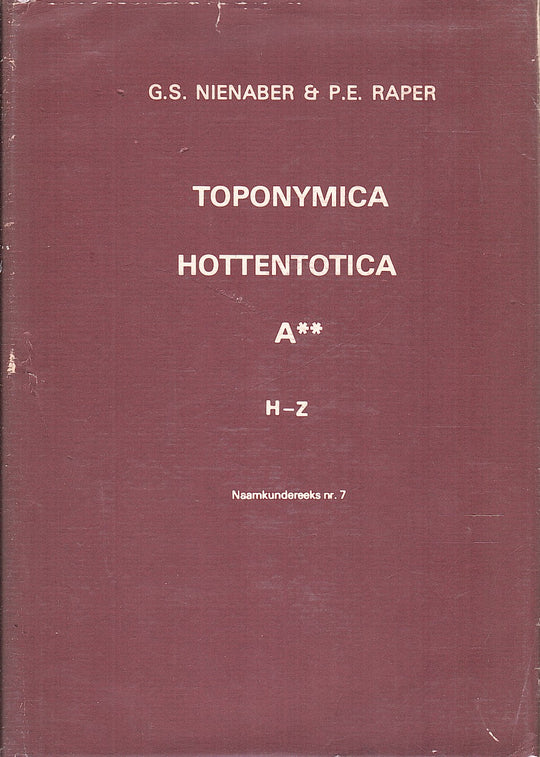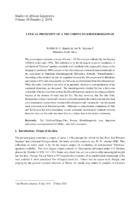-

Ausi told me: Why Cape Herstoriographies Matter
Ausi Told Me: Why Cape Herstoriographies Matter provides fascinating insights into life at the Cape over several centuries, the indigenous inhabitants and their accumulated knowledge, and how attempts were made to systematically erase this knowledge during the colonial and apartheid eras. Yet the wisdom of the ages still resides with the Ausidi, the female, intergenerational knowledge-keepers who are revered for the central role they played in Rondevlei, Hardevlei and other communities on the Cape Flats before the forced removals from the 1960s onwards changed the landscape forever. The book delves into many of the untold stories of the Cape, challenging various scholarly assumptions about the origins and enduring influence of the Khoi and San in the languages and cultures of southern Africa. The meticulously well-researched text is also skilfully interwoven with stories from current and former residents of the Cape Flats who speak candidly about their childhood experiences, the vast expanses of plants and flowers that used to more than satisfy local communities’ food and medicinal requirements, and the Ausidi – the formidable yet selfless family matriarchs, many of whom refused to be cowed by the apartheid regime’s forced removal policy and fought to protect their cherished livestock and land. Ausi Told Me: Why Cape Herstoriographies Matter serves as a reminder that popular history is not unassailable; it should be regularly questioned and, where necessary, challenged. The book makes a powerful case for a decolonised approach to exploring and interpreting southern Africa’s neglected past – in which the stories, dreams, visions and rituals passed down through the generations are recognised once more as critical sources of scholarly knowledge and physical and emotional wellbeing.
-

Toponymica Hottentotica: B (A-Z)
This volume contains the information derived from the second of phase of the authors research project on Khoikhoi topographical names. It provides further insights into the motivations behind Khoikhoi place naming conventions.
-

Toponymica Hottentotica: A2 (H-Z)
This volume provides readers with a list of place and farm names through the lens of the Khoi people. Included with each entry is descriptive information as documentary evidence of that the Khoi place names existed. This specific volume contains the entries from H-Z.
-

Toponymica Hottentotica: A1 (A-G)
This volume provides readers with a list of place and farm names through the lens of the Khoi people. Included with each entry is descriptive information as documentary evidence of that the Khoi place names existed. This specific volume contains the entries from A-G.
-
My tribe is the Hessequa. I’m Khoisan. I’m African’: Language, desire and performance among Cape Town’s Khoisan language activists
In this article we provide a discussion of present-day Khoisan activism in Cape Town, South Africa. The main actors in this movement are people whose heritage is complex: their history can be traced back to the early days of the colonial settlement, reflecting the interactions and cohabitation of the indigenous Khoisan, slaves and the European settlers. Currently, their main languages are English and Afrikaans; yet, efforts are also made by activists to learn Khoekhoegwab. In discussing the Khoisan resurgence we draw on a wide range of sources. The data include: in-depth interviews with language activists; video and audio recordings of ceremonies and other cultural events; discussions and performance of language and identity on blogs and tweets; newspapers; linguistic landscapes; and, finally, artistic performances (with particular focus on the hiphop opera Afrikaaps). We argue that Khoisan activism expresses a deep-seated desire for an identity – linguistic, political and cultural – that is both historically rooted and meaningfully created in the present. Khoisan activism is not only a political program but also an aesthetic-artistic as well as heteroglossic performance, and as such allows for new ways of conceptualizing language revitalization.
-
A forgotten first people: The Southern Cape Hessequa
The present book continues the series on South Africa's 'invisible' earliest people with the Hessequa, who pastured their cattle along the south-east Cape coast -- all the way from the present town of Swellendam to Albertinia, and even beyond -- long before the European colonists arrived. They may be better described as a "Khoekhoe community", rather than what the early history books pejoratively called "Hottentots". In the current dynamic debate in South Africa about the rights of cultural and linguistic minorities, however, the voices of their descendants are not being heard, nor are they appropriately acknowledged by the powers that be. By writing about them and taking up their cause, Mike de Jongh opens a window on their history, their current lives, and their rightful place in the present-day Republic of South Africa.
-
New perspectives on the study of Khoisan
-
Contemporary studies on Khoisan : in honour of Oswin Köhler on the occasion of his 75th birthday
Two volumes
-
Hottentots
-
The phonetics of the Hottentot language
-
The musical practices of the /?Auni and #Khomani Bushmen
Unvailable - can be determined when item is in hand
-

† Lexical proximity of a Xri corpus to Khoekhoegowab
Th paper examines a corpus of some 1 130 Xri concepts collected by Jan Snyman (UNISA) in the early 1970s. This collection is by far the largest corpus of vocabulary of self-declared "Griekwa" speakers available, and is unlikely to be surpassed infuture, as the language is moribund. 1096 concepts of this Xri corpus are compared dialectometrically to the equivalents in Namibian Khoekhoegowab (Khoekhoe, formerly “Nama/Damara”).
-

The cultural heritage of South Africa’s Khoisan
The Khoisan’s /ʹkɔısɑ:n/ approach to culture is a holistic one. Over thousands of years they have cultivated an integrated life-style, undergirded by socio-religious values. In a sense it is therefore artificial to discuss separate cultural issues as if they are silos in the life of this indigenous nation. However, the erosion of their cultural heritage occurred systematically during protracted colonial and neo-colonial eras which allows for a focused approach. Some cultural strands survived the colonial onslaught while others became extinct. In modern times effforts have been made and still are being made, to restore, preserve and promote their heritage. The following five areas will be dealt with here: land, identity, leadership structures, languages and religion. These are all inter-related. Other relevant issues, such as their indigenous knowledge system and legislation protecting their intellectual property, are too complex to be included here. In this chapter we will look at the current state of these 5 foci, their historical context and the possibilities to preserve them for future generations.
-

Wilhelm Bleek and the Khoisan Imagination: A study of censorship, genocide and colonial science
In 1864 Wilhelm Bleek published a collection of Khoi narratives titled Reynard the Fox in South Africa, or Hottentot Fables and Tales. This paper critically examines this foundational event in South African literary history, arguing that it entailed a Victorian circumscription of the Khoisan imagination, containing its libidinal and transgressive energies within the generic limits of the naïve European children’s folktale. Bleek’s theories of language and race are examined as providing the context for his editorial approach to Khoi narratives in which the original ‘nakedness’ was written out. The extent of Bleek’s censorship of indigenous orature becomes visible when comparing his ‘fables’ to a largely unknown corpus of Khoi tales, collected by the German ethnographer Leonhard Schultze during the Nama genocide in the early 20th century. The paper compares these collections of oral narratives, and suggests that this has implications for the way the famous Bleek and Lloyd /Xam archive was subsequently constituted in the 1870s. Wilhelm Bleek’s interventions in civilizing the Khoisan imagination marks a move away from a potentially Rabelaisian trajectory in South African literature through which the Khoisan could be represented and represent themselves. In admitting a sanitized indigenous orature into the colonial literary order, it is argued that Bleek helped to create a restrictive cultural politics in South Africa from which the country is yet to emerge fully.
-

Notes towards a history of Khoi literature
This article puts forward a revisionist history of Khoi literature, and also presents a number of translated Khoi narratives that have not been available in English before. Compared to the large volume of Bushman literature and scholarship, there has been very little Khoi literature and engagement with it, and an argument is presented to account for this gap in South African cultural history. Until now, the major source of Khoi literature was Wilhelm Bleek’s Reynard the Fox in South Africa (1864), and this text is critically interrogated as a limiting version of Khoi orature. An alternative corpus of Khoi narratives is presented that was originally published in Leonard Schultze’s Aus Namaland und Kalahari (1907).
-

Early Khoisan uses of mission Christianity
This essay will examine some of the early religious, political, and economic 'uses' made of mission Christianity by the descendants of the old Khoikhoi communities of the Cape, and those who came to be associated with them, ultimately subsumed under the rubric 'coloured'. Essentially, I want to know why some people converted, why others found mission stations a useful base even if they did not themselves convert, and how Christianity interacted with older beliefs.
-

Khoekhoense stamname: ’n Voorlopige verkenning
In this book Professor Nienaber presents his valuable research on Khoikhoi clan names. It is an accompanying text to another publication entitled "Toponymica Hottentitica" which explores the link between clan names and geographical place names. This particular book explores in greater detail the history of the various Khoikhoi clans who have historically made up this community.
-

Tsuni-//Goam: The Supreme Being of the Khoi-Khoi
An ethnography of the Khoikhoi people, their language and religous beliefs. At the time, the author through this and his other work contributed to the "westerners" understanding of the Khoi and San people.
-

A grammar and vocabulary of the Namaqua-Hottentot language
-

Narrative of an exploratory tour to the north-east of the colony of the Cape of Good Hope
This translated work is from the perspective of French missionaries. It is a narrative of the two authors, Reverend Arbousset and Reverend Daumas, exploratory tour of the north east of the Cape of Good Hope. The aim of the documented missionary tour was to seek out unknown tribes, to open communication channel with the chiefs of these tribes and to formulate missionary plans in order to extend the influence of Christianity and the missionaries civilisation.
-

Ausi told me: Why Cape Herstoriographies Matter
-

Toponymica Hottentotica: B (A-Z)
-

Toponymica Hottentotica: A2 (H-Z)
-

Toponymica Hottentotica: A1 (A-G)
-
My tribe is the Hessequa. I’m Khoisan. I’m African’: Language, desire and performance among Cape Town’s Khoisan language activists
-
A forgotten first people: The Southern Cape Hessequa
-
New perspectives on the study of Khoisan
-
Contemporary studies on Khoisan : in honour of Oswin Köhler on the occasion of his 75th birthday
-
Hottentots
-
The phonetics of the Hottentot language
-
The musical practices of the /?Auni and #Khomani Bushmen
-

† Lexical proximity of a Xri corpus to Khoekhoegowab
-

The cultural heritage of South Africa’s Khoisan
-

Wilhelm Bleek and the Khoisan Imagination: A study of censorship, genocide and colonial science
-

Notes towards a history of Khoi literature
-

Early Khoisan uses of mission Christianity
-

Khoekhoense stamname: ’n Voorlopige verkenning
-

Tsuni-//Goam: The Supreme Being of the Khoi-Khoi
-

A grammar and vocabulary of the Namaqua-Hottentot language
-

Narrative of an exploratory tour to the north-east of the colony of the Cape of Good Hope



